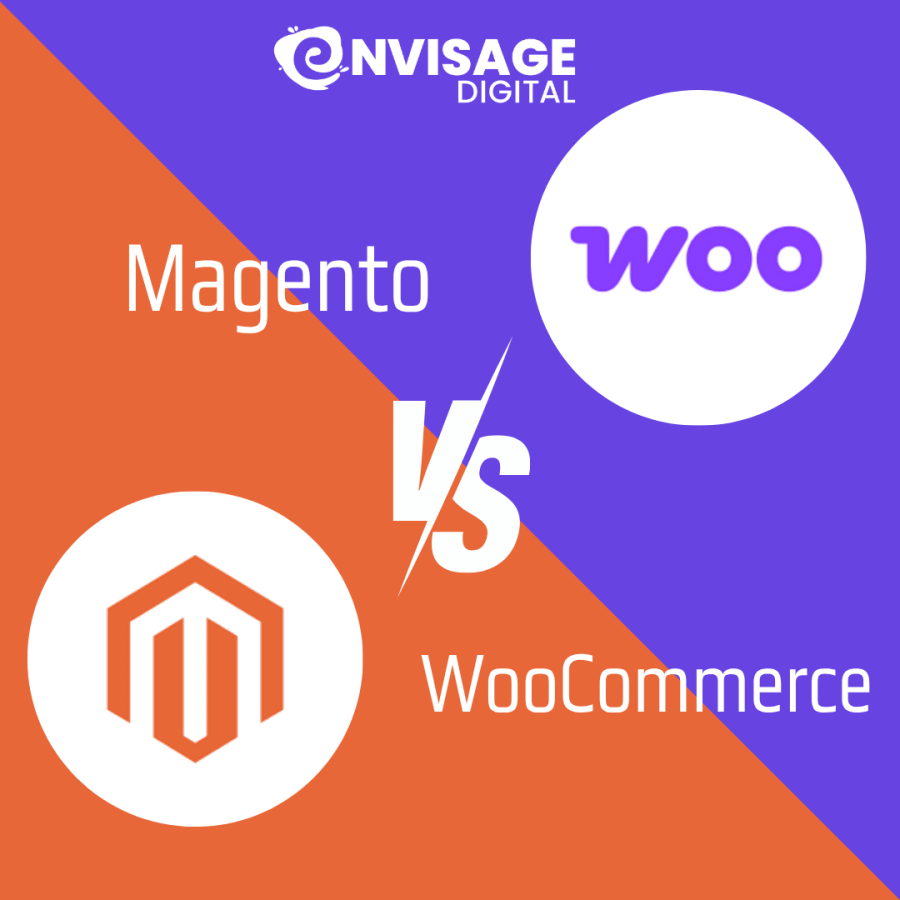Magento vs WooCommerce: Which Platform Should You Choose?.
When it comes to launching or upgrading your ecommerce store, choosing the right platform is one of the biggest decisions you'll make.
That’s why we’ve created a series of blogs, looking at the pros and cons of various big names in eCommerce (take a look at our recent post Magento vs Shopify, with expert commentary from director Brandon Jones).
This time we take a look at Magento vs WooCommerce
: two names that often top the list, but which one’s better for your business?
Both platforms have loyal followings and very different strengths. We’ll break down what each platform offers, where they shine, and when one might suit you more than the other. To help with the design angle, we also asked Michael Sumner, Designer at Envisage Digital, to weigh in.


Mangeto vs WooCommerce: A Quick Overview
Magento (Adobe Commerce for paid platform) is a powerful, open-source ecommerce system tailored for larger operations. It’s flexible, customisable and built for growth; but it does need technical know-how to get the most out of it.
WooCommerce, on the other hand, is a plugin for WordPress that transforms a standard site into a fully functional online shop. It’s simple to set up, easier to manage, and perfect for smaller teams or businesses just getting started.

Magento: Pros & Cons
The Good
Highly adaptable: Magento is built for custom solutions, from advanced filtering to complex checkout flows.
Handles scale well: Ideal for businesses with big ambitions or large product ranges.
Lots of features: Out of the box, you get multi-store support, customer groups, layered navigation, and more.
Security-first: With regular patches and support, it’s built with enterprise-grade protection in mind.
The Trade-Offs
Complex setup: You’ll likely need a development team to build and maintain your store.
Higher costs: From hosting to custom builds, expect to invest more compared to lighter platforms.
Performance tweaks needed: Magento can be resource-heavy unless optimised properly.
Security depends on updates: You’ll need to stay on top of maintenance to keep things secure.

WooCommerce: Pros & Cons
Why People Love It
Simple to start: If you’re already using WordPress, adding WooCommerce is quick and straightforward.
Budget-friendly: Lower setup and running costs, especially for small businesses or startups.
Tons of plugins: Extend functionality easily with add-ons for shipping, marketing, payments and more.
User control: You’re not tied into a specific provider - host it your way, on your terms.
What to Watch Out For
Can become bloated: Too many plugins can slow your site down or create compatibility issues.
Less suited to enterprise use: Managing thousands of products or complex customer groups can get tricky.
Security depends on updates: You’ll need to stay on top of maintenance to keep things secure.
Final What About Design Flexibility?
Design can be the deciding factor for many businesses; and both platforms offer plenty of scope for creativity. That said, their design capabilities work a little differently.
“Magento gives you room to create something truly bespoke,” says Michael Sumner, Designer at Envisage Digital. “You have the freedom to build a tailored user experience, especially for high-volume or luxury brands.”
WooCommerce still holds its own, especially for brands that need a faster turnaround.
“WooCommerce is perfect when speed and simplicity are key,” Michael adds. “With the right theme and a bit of clever styling, you can still build something clean, branded and professional, without starting from scratch.”


WooCommerce vs Magento: Which One Is Right for You?
There’s no one-size-fits-all answer: it depends on your goals, budget, and how much control you want.
Go with Magento if you’re building something large, custom, or long-term and need advanced functionality from the start.
Choose WooCommerce if you want something flexible, cost-effective, and easier to manage without a dedicated dev team.
Still Weighing Up Your Options?
At Envisage Digital, we work with both platforms day in and day out. Whether you’re launching a brand new store or looking to switch platforms, we can help you find the right fit for your needs - today and into the future.
Let’s have a chat. We’ll guide you through your options and help you get set up with the platform that makes the most sense for your business.

Latest Posts
Everything you need to become a successful eCommerce developer
Adobe has recently launched Magento 2.4.6, the most advanced version of the Magento Commerce and Open Source platform,...
Read the full blogEverything You Need to Know About the Magento 2.4.6 Update.
The day to day life of being a eCommerce developer and what it entails.
Read the full blogA Deep Dive into Magento’s Release Schedule
Dive into the heart of the Magento release schedule overhaul, uncovering its monumental shift and direct benefits for...
Read the full blog


